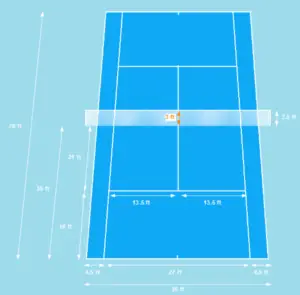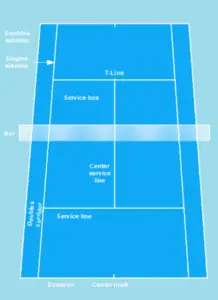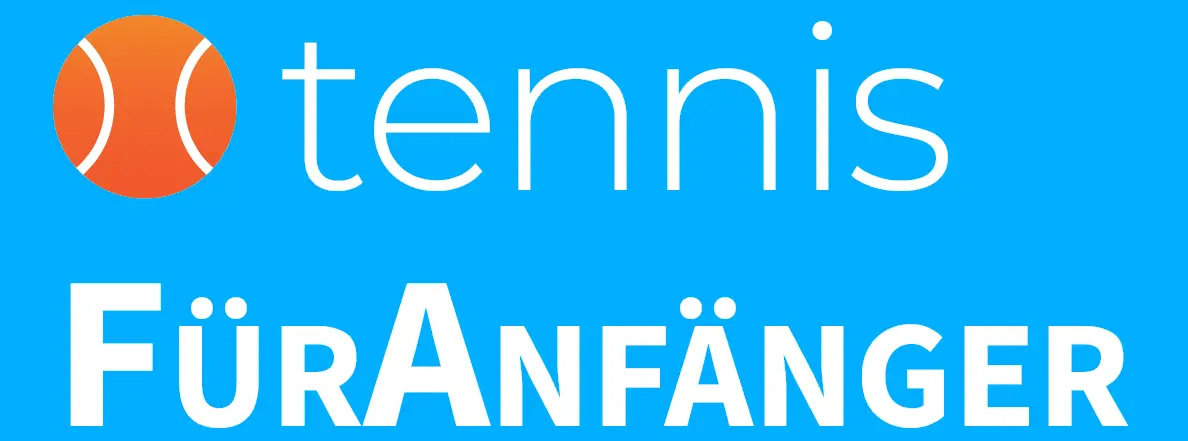Everything you need to know about the tennis court
Introduction to the world of tennis courts
Everything you need to know about the tennis court
On the tennis court, a large number of tennis players pursue their favorite hobby of tennis. Tennis courts usually have a concrete, sand or ash surface outdoors and a concrete or carpet surface indoors. However, there are also other floor coverings, e.g. grass courts.
Depending on the surface, tennis balls bounce differently. Also the spin of the tennis strokes, e.g. topspin or slice, is accepted differently by the floor. As a result, successful tennis players on one tennis surface are not necessarily as successful on all other tennis surfaces.
In the following we explain the characteristics of tennis courts and give tips and tricks for tennis beginners for each surface.
1. Tennis court introduction - dimensions and size
How big is a tennis court and what are the lines and fields of a tennis court?
The tennis court is 78 ft long and 27 ft wide in singles, which is narrower than in doubles. The tennis court is 78 ft long and 36 ft wide in doubles, where two tennis players cover one side of the net. Thus, the two outer corridors count only in tennis doubles.
The service box, also called the T court, is 21 ft long and 13.5 ft wide in both singles and doubles. The serve must be played diagonally into the left or right service area, also called cross court in tennis.
The net separates the court into two halves and is 3.5 ft high at the outer posts, which are outside the doubles court, and sags to 3 ft in the middle. When playing singles, there are still so-called net supports, also called single poles, which also have a height of 3.5 ft, each at a distance of 3 ft from the outer post on both sides in the net.
It is important to mention that the entire line belongs to the tennis court and thus to the field. If a ball touches the line, even minimally, the tennis ball is in the field and not out.


2. Tennis court surfaces
In the open air, sand or ash tennis courts are preferred in Europe and South America, hard courts in North America, and especially grass courts in Great Britain. In indoor tennis courts, on the other hand, carpet or hard courts are preferred.
a) Sand or ash tennis court
The reddish tennis ash is the classic image at the French Open, the Grand Slam tournament in Paris.
The reddish grains usually consist of crushed bricks. To the delight of tennis players, this means that the heat is not reflected, which makes playing tennis in the summer much more pleasant. At the same time, on clay courts it is possible to slide to the tennis ball and thus make fewer deceleration movements that go on the joints.
The sand court belongs to the slower tennis courts due to the high frictional resistance of the crushed bricks. Therefore, baseline play and long rallies are preferred to the attacking serve-and-volley game. A fast serve can also be defused much better on clay courts.
b) Hard court
The classic tennis hard courts in North America, on which the US Open, the Grand Slam tournament in New York, is also played, are among the faster surfaces. The Australian Open, the Grand Slam tournament in Melbourne, is also played on synthetic hard courts.
The hard courts are applied in layers, e.g. of acrylic, rubber or silicon, to the asphalt base. Due to the level ground layers, the bounce is constant and can be judged much better by the tennis players than on clay courts.
c) Grass court
The green grass courts are probably known to every tennis fan from Wimbledon in London. The grass court is the fastest surface in tennis and used to be used almost exclusively for serve-and-volley. The strong serve-and-volleyers often achieve the greatest successes due to the short rallies on grass.
On grass, tennis balls bounce much flatter and faster, so players are constantly under pressure and often hit the ball too late. The court changes its bounce behavior due to the hardness and density of the grass. The hard and dense ryegrass at Wimbledon since 2001 has made the tennis courts a little slower, so serve-and-volley is used less frequently.
d) Carpet
Although no Grand Slam tournament is held on carpet, it has been used on the professional tour since 2009. The speed of the carpet is similar to that of a grass court, and tennis balls bounce flat accordingly.
3. Tennis court care and accessories
Playing tennis involves taking care of the tennis courts. In the following, we report on what needs to be observed on the high-maintenance reddish ash, so that the club’s own groundskeeper has nothing to complain about.
In the spring, the tennis court is always extensively maintained by rolling, watering, installing screens, etc., but nevertheless, before and every game, the court must also be actively maintained by the tennis players.
a) Watering the court
Before playing tennis, especially on hot summer days, the tennis court should be sufficiently watered. This applies not only to the tennis court but to all areas where players move when running after the tennis ball. The surface should be clearly moist, so that the ashes are not stirred up when playing.
Either the court has an irrigation system that simply needs to be turned on, or you can reach for the hose yourself and water the court. Incorrectly set irrigation systems like to spray the water onto the benches, so it is best to take your tennis equipment off the court again before turning it on.
In extremely hot temperatures, the tennis court should also be watered at least once in between.
b) Take off the court
After an intense tennis match, there are often many ball marks on the cinder court as well as footprints. Therefore, it is advisable to clean the tennis court evenly with a drag net, right into the corners of the tennis court.
c) Clean the lines
After the tennis court has been cleaned, the lines must be cleaned with a line broom so that the white lines can be clearly seen again from the other side of the net.
In addition, there is a referee’s chair and a scoreboard on the tennis court, where the score can be set for the spectators present during a match.
Nevertheless, the groundsman additionally maintains the tennis courts during the whole summer season, so that there are no unevennesses on the tennis court. If the tennis club does not have its own groundskeeper, the task is often transferred to the members.
For this purpose, a work service is often created. Either the members perform a certain number of hours on the tennis court or they pay a corresponding amount for each hour not performed.
We recommend all tennis beginners to take part in a potential work service, because on the one hand this is a way to get to know other members and potential playing partners and on the other hand it is a first step into active club life. An active club life distinguishes every tennis club.
4. Rent tennis court near
You can most likely find a tennis club or tennis courts in your local area regardless of whether you are looking for an outdoor or indoor tennis court.
To rent a tennis court – even without membership – simply contact the tennis club or the private provider and bring the right tennis shoes to play.
5. Summary and conclusion
Court maintenance is as much a part of playing tennis as the serve on clay courts. Watering the court, stripping or cleaning lines should not be foreign words to tennis beginners and should be applied every time you play.
Have fun playing tennis.

